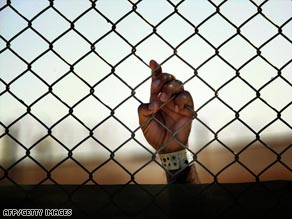
The one-star general almost yells when asked to talk about the infamous Abu Ghraib photos showing U.S. soldiers abusing Iraqi detainees.
“If we had had a company commander doing what he was supposed to be doing, a battalion commander doing what he was supposed to be doing …” Brig. Gen. David Quantock said. He carried on — growing more and more angry. So the next obvious question was, “It makes you angry” “It does make me angry,” he said. “Because I think we lost a lot of American lives because of those photos.” And there it is — the issue of detainee abuse and what the U.S. military struggles with, and has struggled with, since the release of those photos in 2004, some of which showed naked prisoners being humiliated, stacked in piles or subjected to mock torture. Quantock, the head of detainee operations in Iraq, is echoing a debate raging in Washington. Another round of photos allegedly showing further abuse of prisoners was to be released by the end of this month. But President Obama asked that the photos be held back. Obama said he believed the release of the pictures could put American lives in danger. That is catch-22 situation No. 1: on one hand transparency; on the other, the safety of U.S. troops.
Don’t Miss
Justice Department prepared to fight detainee photo release
Obama orders stop to release of alleged abuse photos
Pentagon to release hundreds of photos
Quantock agreed with his commander-in-chief. “The jihadists have used those pictures. And it has spurred some of the violence,” he said. Walking through Camp Cropper — one of the last remaining U.S. detention centers in Iraq — it is clear the very damaging photos have forced the United States to become more transparent in its dealings with prisoners. Detainees are now checked before and after interrogations to ensure the guards have not abused them. Officers who walk the catwalk, the long metal walkway that surrounds the sprawling yard housing the detainees, have more oversight. These institutional checks reduce the possibility that abuse could reach the same scale as it did in Abu Ghraib in 2003. The camp itself has a strange feeling to it. Visitors are told to put on sunglasses before entering some of the holding areas. Many of the detainees spit, and even throw their own fecal matter at the guards, officials said. Inmates in U.S. detention with arrest warrants against them will be turned over to Iraqi authorities under the terms of the U.S.-Iraqi security agreement. All others will be released. But the United States has signed the international treaty against torture, which compels a nation to keep suspects detained rather than send them to another country if that other country might ill-treat them. “Iraqi detention facilities are not good, they are not like American facilities,” said a woman who had just visited her detainee husband at Camp Cropper. “There is a lot of witness testimony from detainees who suffered maltreatment in Iraqi detention facilities.” A U.N. report examining the second half of 2008 agreed, saying that detention centers run by Iraqis are using torture and physical abuse to extract confessions. The lingering questions about Iraqi detention facilities create catch-22 situation No. 2. The United States very much wants not only to get out of Iraq, but to get out of the detainee operation business. But it has a legal bar to satisfy. For its part, the U.S. military says it is inspecting and monitoring nine of the Iraqi facilities where its detainees will go. Iraqi government authorities maintain that they are treating all prisoners in accordance with international law. But when the United States pulls its last troops form Iraq, the monitoring is likely to stop. Nongovernmental organizations have been denied access and CNN recently has not been allowed into any Iraqi prison. We simply do not know what is happening inside these facilities.